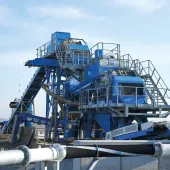CDE help reduce clay contamination in Russia

M2500 washing plant ensures natural sand product complies with Russian standards for concrete
A NEWLY commisioned M2500 sand washing plant from CDE is successfully processing clay-contaminated material for Stroytekhservis Cherepovets at their natural sand and gravel quarry to ensure their final sand product complies with Russian standards for concrete production.
Established in 2005 and specializing in the production, sales and transportation of sand and aggregates, Stroytekhservis Cherepovets are based in the west of Vologda Oblast, Russia. The company has recently purchased a new M2500 washing plant which is significantly reducing clay and dust contamination and producing a range of washed sand and aggregates. The plant was delivered by CDE in conjunction with Mining Technologies, their sales partner in Russia.
Stroytekhservis Cherepovets approached Mining Technologies in September 2012 and presented a natural sand and gravel material containing more than 8% clay content which had to be cleaned. Stroytekhservis required a 120 tonnes/h plant capable of producing four washed and sized products: a 0–3mm building sand, a 3–5mm concrete sand, a 5–25mm aggregate and a +25mm aggregate. The raw material is 0–40mm sand and gravel.
Stroytekhservis also required a water-treatment system as they had limited space to accommodate settling ponds and also wanted to reduce the requirement for fresh water to feed the plant.
After a thorough sieve analysis at the quarry, the equipment specified to process the material was a M2500 washing plant and an AquaCycle thickener. Mining Technologies invited representatives from Stroytekhservis to visit a nearby CDE installation in Priozersk in the Leningradsky region.
This visit demonstrated how the M2500 and AquaCycle combination could be used successfully in the processing of material with clay and dust contamination. ‘We were impressed by the capability of the M2500 and AquaCycle to produce high-quality sand and aggregates and realized how the system could be applied at our Cherepovets quarry,’ said Kalashnikov Vitaly, CEO of Stroytekhservis Cherepovets.
‘It was very important that the final sand product should meet the standard specification for concrete production. The M2500 produces in-specification products which comply with this standard and, therefore, are suitable for construction works as clay and dust particles in the final product are 0.2%,’ explained Vitaly Vizir, deputy CEO for sales for Mining Technologies.
The plant also includes an AquaCycle thickener, which was selected for its recycling benefits as it significantly reduces the volume of fresh water required, with up to 90% of the water used in the washing plant being recirculated around the plant.
Material first enters the plant via a M14 feed hopper where a manual tipping reject grid removes any +150mm material. The M2500’s integrated feed conveyor delivers the material to a ProGrade screen. CDE transfer point technology specifies that the belt width is 1,000mm, which is the same width as the belt feeder. This ensures minimal wear, no spillage and maximum efficiency when material passes between the hopper and conveyor.
‘CDE transfer point technology is evident in the entire CDE product range and is central to the design of our equipment,’ explained Eoin Heron, senior sales manager in Europe and Russia for CDE Global. ‘We are focused on reducing wear, ensuring the smooth flow of material and minimizing the lifetime cost of ownership on our plants for our customers. Polyurethane wear pads are also fitted at this transfer point which further increases wear resistance.’
From the feed conveyor, material is discharged to the ProGrade P2-75 double-deck rinsing screen. Here, the top deck removes the +25mm material, which is stockpiled using one of the 9m wing conveyors, while the bottom deck comprises a split screen whereby the 0–3mm material passes through the first section while further down the screen the apertures increase in size to allow the 3–5mm material to pass. The 5–25mm product travels down the screen and goes directly to the M2500 unit’s second stockpile conveyor.
The 3–5mm material is transferred, via jet pump, to one half of the polyurethane dewatering screen on the integrated EvoWash sand washing plant. Replaceable polyurethane side-wall protection on the EvoWash screen minimizes material-on-steel contact, reducing wear and increasing the working life of the machine. The 3–5mm product is stockpiled via the third M2500 conveyor.
The split dewatering screen allows two products to be dewatered at the same time. Before the 0–3mm product reaches the dewatering screen it is pumped from the bottom deck of the ProGrade to the hydrocyclone on the EvoWash, to ensure accurate separation of silts and clays from the final washed sand product. The fine sand fraction is discharged, via the cyclone underflow, to a rubber-lined feedbox which distributes the material evenly on to the second side of the dewatering screen. This product is stockpiled from the fourth M2500 conveyor.
Meanwhile, the –63micron fraction overflows the hydrocyclone and is transferred, together with the waste water, to the next stage of processing. This overflow is discharged at the highest point of the plant, thereby negating the need for additional pumping.
Excess fines pass to the AquaCycle A400 thickener complete with CDE FlocStation. The design of the AquaCycle allows for high-rate settlement of the fine particles to the bottom of the thickener tank, while the FlocStation acts as the delivery system for polyelectrolyte to the AquaCycle to facilitate the settlement of the sludge.
A set of rakes at the bottom of the tank ensure that the sludge is maintained at an even consistency before it is discharged to ponds, while clean water overflows the thickener and is recycled to an AS404 water tank (a complete water storage and pumping system for the recycling of recovered water around the washing plant).
The new plant has been running since July 2013 and Stroytekhservis’s CEO Kalashnikov Vitaly is extremely happy with its performance. ‘The CDE washing plant has solved our problem of clay contamination. It is successfully washing off dust and clay so now the final product complies with the necessary regulations for concrete sand,’ he said.









